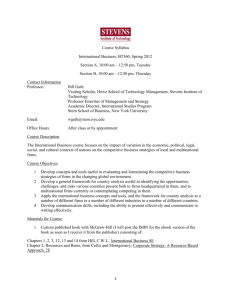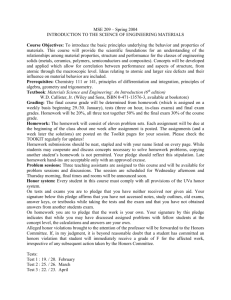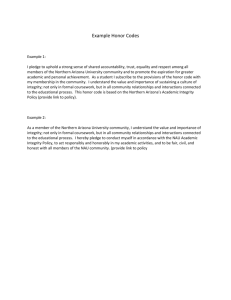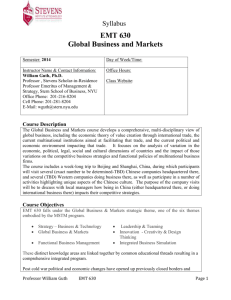International Business, BT360, Fall 2014
advertisement
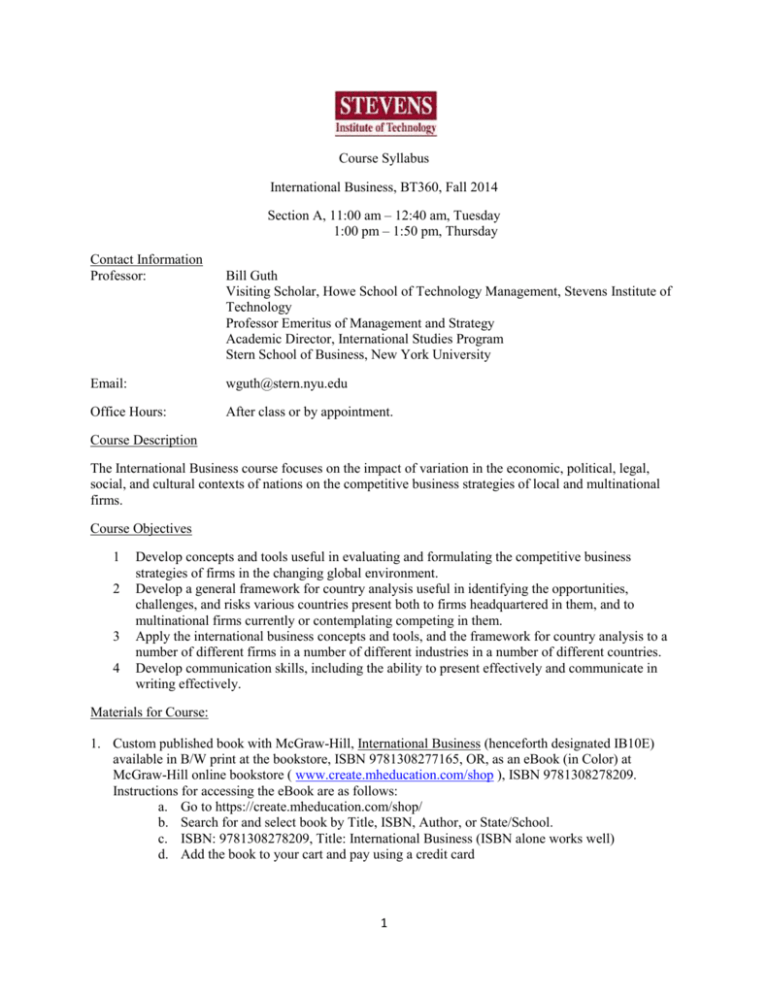
Course Syllabus International Business, BT360, Fall 2014 Section A, 11:00 am – 12:40 am, Tuesday 1:00 pm – 1:50 pm, Thursday Contact Information Professor: Bill Guth Visiting Scholar, Howe School of Technology Management, Stevens Institute of Technology Professor Emeritus of Management and Strategy Academic Director, International Studies Program Stern School of Business, New York University Email: wguth@stern.nyu.edu Office Hours: After class or by appointment. Course Description The International Business course focuses on the impact of variation in the economic, political, legal, social, and cultural contexts of nations on the competitive business strategies of local and multinational firms. Course Objectives 1 2 3 4 Develop concepts and tools useful in evaluating and formulating the competitive business strategies of firms in the changing global environment. Develop a general framework for country analysis useful in identifying the opportunities, challenges, and risks various countries present both to firms headquartered in them, and to multinational firms currently or contemplating competing in them. Apply the international business concepts and tools, and the framework for country analysis to a number of different firms in a number of different industries in a number of different countries. Develop communication skills, including the ability to present effectively and communicate in writing effectively. Materials for Course: 1. Custom published book with McGraw-Hill, International Business (henceforth designated IB10E) available in B/W print at the bookstore, ISBN 9781308277165, OR, as an eBook (in Color) at McGraw-Hill online bookstore ( www.create.mheducation.com/shop ), ISBN 9781308278209. Instructions for accessing the eBook are as follows: a. Go to https://create.mheducation.com/shop/ b. Search for and select book by Title, ISBN, Author, or State/School. c. ISBN: 9781308278209, Title: International Business (ISBN alone works well) d. Add the book to your cart and pay using a credit card 1 This custom book contains the following: Chapters 1, 2, 3, 4, 13, 14 and 15 from Hill, C.W.L., International Business 10E Chapter 2, Resources and Rents, from Collis and Montgomery, Corporate Strategy: A Resource-Based Approach, 2E 2. A coursepack of 13 cases from HBS Publishing (link to coursepack https://cb.hbsp.harvard.edu/cbmp/access/28072033: a. Wal-Mart in Europe b. Grolsch: Growing Globally c. Dabur India: Globalization d. Yomato Transport: Replicating Japanese Success in Singapore e. Denmark: Globalization of the Welfare State f. Spain: Can the House Resist the Storm? g. Finland and Nokia: Creating the World’s Most Competitive Economy h. Dogus Group: Weighing Partners for Garanti Bank i. HCL Technologies (A) j. Philips vs. Matsushita: The Competitive Battle Continues k. Bosch India: Becoming a Transnational Organization l. P&G Japan: The SK-II Globalization Project m. Kent Chemical: Organizing for International Growth 3. Chapter 1.1 of the Global Competitiveness Report, 2013-2014, downloadable from http://www.weforum.org 4. Additional materials (e.g., articles by Guth, WD) either passed out in class or provided electronically Pedagogy The course will be delivered in two interacting modes: 1) Lecture-discussion, and 2) Case discussion. Typically (but not always), a lecture-discussion class, based on the readings assigned for that class, will be followed by a case discussion class which applies the concepts, tools, research findings and general experience developed in the lecture-discussion class. For this approach to work well, it is important that all students come prepared to participate in each class. This means carefully reading the materials assigned for the lecture-discussion classes, noting key points made and questions raised in your mind; and, it means carefully answering the questions (I will distribute them separately each week) suggested for the case assigned for the case discussion classes, and any others you find particularly interesting. Deliverables/Assignments/Grade Weights 1. Two written team case reports making strategic recommendations to company management – 20% (10% each) 2. A mid-term exam – 30% 3. In-class team presentation of strategic analysis and recommendations to management of the Kent Chemical Company– 20% 4. Final individual report presenting and supporting your individual recommendations after reviewing all the team presentations – 20% 2 5. Class Participation – 10% Ethical Conduct Enrollment into the undergraduate class of Stevens Institute of Technology signifies a student's commitment to the Honor System. It is the responsibility of each student to become acquainted with and to uphold the ideals set forth in the Honor System Constitution. Specific student responsibilities include: Maintaining honesty and fair play in all aspects of academic life at Stevens. Writing and signing the pledge, in full, on all submitted academic work. Reporting any suspected violations to an Honor Board member or to the Dean of Student Development. Cooperating with the Honor Board during investigations and hearings. Pledge of the Honor System The pledge signifies that the work submitted by a student is indeed his/her own. There is one designated pledge to be used for tests, homework assignments, lab reports, and computer projects. The pledge shall be written in full and signed by the student on all submitted academic work. Any references used (including texts, tutors, classmates, etc.) should be listed below the written pledge. "I pledge my honor that I have abided by the Stevens Honor System." Grading Scale Grade Score Grade Score A 93-100 C 73-76 A- 90-92 C- 70-72 B+ 87-89 D+ 67-69 B 83-86 D 63-66 B- 80-82 D- 60-62 C+ 77-79 F <60 3 BT 360 – International Business Fall, 2014 Section A, 11:00 am – 12:40 am, Tuesday 1:00 pm – 1:50 pm, Thursday Cla ss # 1 Date Topics 8/26 T Course introduction and overview 2 8/28 Th Globalization and the multinational enterprise (MNE) 3 9/2 T 4 9/4 Th 5 9/9T 6 9/11 Th 7 9/16 T 8 9/18 Th International strategy for competitive advantage Profiting from international expansion Location bound versus non-location bound firm specific advantages Leveragability of intangible versus tangible assets across national boundaries Basing international strategy on strategically valuable resources How does “country” matter in international competition? How countries differ: political, economic, legal systems Strategic challenges for companies in rich, poor, and developing countries Assignment Read: Course Syllabus Hill, Chapter 1, “Globalization,” International Business , (IB10E) Guth, WD, “New Avenues for Growth: Challenges of Five Major Trends in the Global Environment “ (on Moodle) Think: 1) Why do managers of firms want to expand beyond their national boarders? 2) Why must some firms expand beyond their national borders? 3) What is required for a firm successfully to expand beyond its national borders? 4) How should managers go about picking national markets for expansion, and the approach to entering those markets? Find in the newspapers an example of a firm that has made a major international expansion move to help you think about these questions. Read: Hill, Chapter 12, The Strategy of International Business, (IB10E) Prepare for discussion: Wal-Mart in Europe Read: Collis and Montgomery, Chapter 2, “Resources and Rents,” Corporate Strategy: A Resource-based Approach” (IB10E) Ghemawat, “Distance still matters: The hard reality of global expansion”, HBR (2001) – to be distributed Prepare for discussion: Grolsch: Growing Globally Read: Hill, Chapter 2, “National Differences in Political Economy”, (IB10E) “Emerging Giants: Building World-Class Companies in Emerging Markets” (To be distributed) Prepare for Discussion: Dabur India - Globalization 4 9 9/23 T How countries differ: societies and cultures Adapting strategy to differences in culture 10 9/25 Th 11 9/30 T The macro and microeconomics of country competitiveness Theories of the economic growth of countries Team Meetings 12 10/2 Th Societal values and economic growth 13 10/7 T 14 10/9 Th 15 10/14 10/16 Th Regional trading blocks Regional affiliation and country economic strategy Linking country competitiveness with firm competitiveness Class Recess – No Classes Team Meetings 16 17 10/21 T 10/23 Th Mid-Term Exam Assessing country markets for entry 18 10/28T Overcoming country/firm weaknesses through alliances 19 10/30 Th Formulating, revising and reorienting international strategy 20 11/4T 21 11/6 Th 22 11/11 T 23 11/13 Th Leadership and international strategy Organizing the MNC The Role of Administrative Heritage The Transnational Solution Read: Hill, Chapter 3, “Differences in Culture”, (IB10E) Prepare for discussion: Yomato Transport: Replicating Japanese Success in Singapore Read: Chapter 1.1, The Global Competitiveness Report, 20132014, available at http://www.weforum.org Prepare for Discussion: Denmark: Globalization of the Welfare State Team Report #1 due (See separate assignment guidance sheet for details) Prepare for Discussion: Spain: Can the House Resist the Storm Prepare for Discussion: Finland and Nokia: Creating the World’s Most Competitive Economy Review major course concepts and tools, and key case “takeaways” Read: Hill, Chapter 14, “Entry Strategy and Strategic Alliances”, (IB10E) Prepare for Discussion: Dogus Group: Weighing Partners for Garanti Bank Read: Guth, “Strategic Inertia – A Cognitive Perspective “ – lecture slides Mezias, Grinyer and Guth, “Changing Collective Cognition: A Process Model for Strategic Change” Guth, “Leadership and Rhetoric” (Note to be distributed) Prepare for Discussion: HCL Technologies (A) Read: Hill, Chapter 14, “The Organization of International Business”, (IB10E) Prepare for Discussion: Philips vs. Matsushita: The Competitive Battle Continues Reading: To be announced 5 24 11/18 T The Transnational Solution ???????? 25 11/20Th 26 11/25 T 27 28 12/2 T 12/4 Th Managing innovation globally Global scale versus local responsiveness Managing the Global Firm Prepare for Discussion: Bosch India: Becoming a Transnational Organization Team report #2 due – (see separate assignment guidance sheet for details) Reading: To be announced Prepare for Discussion: P&G Japan: The SK – II Globalization Project Read: Kent Chemical: Organizing for International Growth Final individual report due – 12/11/14 Th 6
